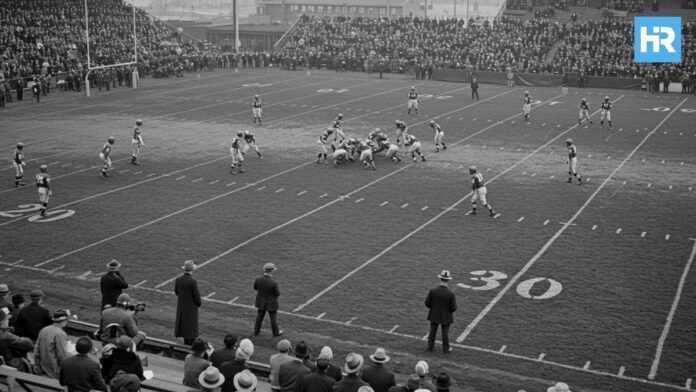Rivalries are what make sports exciting; there’s no question, really. They turn regular games into must-watch events and bring out the best, and sometimes the worst, in teams and players. When two opponents meet again and again with something to prove, it creates history.
This list looks at ten of the biggest rivalries in sports – the matchups that fans never forget, where every game feels personal, and every point or goal carries extra significance.
- Michigan and Ohio State’s football rivalry includes 119 games, began in 1897, and ties back to the 1835–36 Toledo War between the two states.
- The Red Sox and Yankees have played 2,317 times as of June 2025, with the Yankees leading the series and both teams splitting 12–12 in postseason wins.
- Chris Evert and Martina Navratilova faced each other 80 times from 1973 to 1988, including 60 finals, with Navratilova leading 43–37 overall.
1. Green Bay Packers vs. Chicago Bears
The first meeting in the storied rivalry between the Green Bay Packers and the Chicago Bears took place on November 27, 1921, when the Chicago Staleys, the franchise that would become the Bears, defeated the Packers 20–0.
As of January 5, 2025, the two teams have played 210 times, the most games between two franchises in NFL history. The overall series record stands at 108 wins for the Packers, 96 for the Bears, and 6 ties. In the regular season, the Packers lead 107–95–6, and the postseason record is split 1–1.
Two of the largest margins of victory in the series came in 1980, when the Bears won 61–7, and in 1962, when the Packers prevailed 49–0.
The Packers overtook the Bears in the all-time series standings in 2017 and have maintained the lead since then. From 2019 to 2024, Green Bay went on an 11-game winning streak against Chicago, though it ended on January 5, 2025, when the Bears won 24–22 in their most recent matchup.
Collectively, the two franchises have won 22 NFL championships—13 for Green Bay and 9 for Chicago. They also account for 77 Pro Football Hall of Fame inductees, with 41 from the Bears and 36 from the Packers.
The rivalry’s regional tension stems from Chicago, one of the country’s largest cities, and Green Bay, the smallest NFL market. The term “cheeseheads,” originally a slur used by Chicagoans, was embraced by Packers fans, who now famously wear cheese-shaped foam hats at Lambeau Field.
2. Los Angeles Lakers vs. Boston Celtics
The Los Angeles Lakers and Boston Celtics have met in the NBA Finals 12 times, the most frequent matchup in Finals history. The Celtics have won 9 of those series; the Lakers have won 3.
Their first Finals matchup occurred in 1959, when the Boston Celtics swept the Minneapolis Lakers 4–0. Boston continued to dominate the rivalry in the 1960s, winning six Finals matchups against the Lakers during that decade.
In the 1980s, the teams met in the Finals three times—in 1984, 1985, and 1987. Boston won in 1984, while Los Angeles secured victories in 1985 and 1987.
Since the Lakers relocated to Los Angeles in 1960, the teams have met 207 times in the regular season. As of the end of the 2023–24 season, the Celtics lead the regular-season series 111–96.
Including titles won during the Minneapolis Lakers era, the Lakers have 17 NBA championships, while the Celtics hold 18, making them the two winningest franchises in NBA history.
As of the conclusion of the 2023–24 season, both franchises have an all-time winning percentage of .592, but Boston is the only NBA team with a winning record against the Lakers.
This rivalry features iconic individual matchups like Magic Johnson vs. Larry Bird and Bill Russell vs. Wilt Chamberlain, and defining moments such as Red Auerbach lighting victory cigars on the Boston Garden floor and Pat Riley orchestrating “Showtime” in Los Angeles while dressed in Armani suits.
In the 1980s, the rivalry took on deeper complexity when the Celtics fielded a predominantly white starting lineup during a time when the NBA was largely dominated by Black athletes. Although not publicly dissected as part of a national conversation, it was noticeable to fans. In earlier decades, the Celtics had fielded a lineup featuring at least four Black starters—a rarity at the time.
3. Joe Frazier vs. Muhammad Ali
Muhammad Ali and Joe Frazier fought three times between 1971 and 1975, creating one of boxing’s most iconic rivalries.
Their first bout, widely billed as “The Fight of the Century,” took place on March 8, 1971, at Madison Square Garden in New York City. Both fighters entered the ring undefeated: Ali was 31–0, and Frazier was 26–0. At the time, both were considered world heavyweight champions—Ali held the lineal title, while Frazier was recognized by the WBA, WBC, and The Ring as the undisputed champion. After 15 rounds, Frazier won by unanimous decision, successfully retaining the undisputed heavyweight title.
The rematch, dubbed “Super Fight II,” occurred on January 28, 1974, also at Madison Square Garden. This time, the fight was not for the championship, as George Foreman had since claimed the heavyweight titles. However, the stakes remained high. Ali won by unanimous decision, leveling their rivalry at 1–1.
Their final encounter, the legendary “Thrilla in Manila,” took place on October 1, 1975, at the Araneta Coliseum in Cubao, Quezon City, Philippines. The bout was for the undisputed heavyweight championship, which Ali had regained after defeating Foreman in 1974. The fight was brutal, lasting 14 rounds. At the end of the 14th round, Frazier’s trainer, Eddie Futch, stopped the fight, resulting in a technical knockout victory for Ali. Ali retained his championship and later described the fight by saying it was “the closest thing to dying I know of.”
Throughout their trilogy, Ali was known for his graceful, tactical boxing style, whereas Frazier was relentless, using a signature bobbing-and-weaving approach to apply constant pressure.
4. Boston Red Sox vs. New York Yankees
The rivalry between the Boston Red Sox and New York Yankees began on May 7, 1903, at Huntington Avenue Grounds in Boston, where the Boston Americans defeated the New York Highlanders 6–2. The game lasted 1 hour and 38 minutes and was attended by 5,462 spectators.
As of June 15, 2025, the two teams have played 2,317 games, with the Yankees leading the all-time series. In the postseason, they are evenly matched, with both teams securing 12 wins each across 24 playoff meetings.
The Yankees’ largest margin of victory in the rivalry was a 22–1 win on June 19, 2000, scoring 16 runs in the final two innings. The Red Sox delivered dominant wins of 17–1 on May 28 and July 15, 2005, and a 19–3 victory on July 25, 2019.
The Yankees have posted three separate 12-game winning streaks in the rivalry. The Red Sox hold the record for the longest single streak, with 17 consecutive wins from October 3, 1911, to July 1, 1912.
The Red Sox are on a five-game winning streak, capped by a 2–0 shutout win in which Brayan Bello struck out eight batters, Rafael Devers hit a home run, and Trevor Story added an RBI single.
This rivalry has now lasted more than 120 seasons and remains one of the most storied and competitive rivalries in all of American professional sports.
5. Ohio State vs. Michigan (College Football)
The football rivalry between Michigan and Ohio State began on October 16, 1897, in Ann Arbor, where Michigan won 34–0 at Regents Field. Since 1918, the two programs have played annually, with only one exception in modern history.
As of November 30, 2024, Michigan leads the series 62–51–6.
The largest margin of victory belongs to Michigan, which won 86–0 in 1902. Michigan also holds the longest winning streak in the rivalry: nine consecutive wins from 1901 through 1909.
The rivalry’s deeper context includes the Toledo War of 1835–1836, a boundary dispute between the states of Michigan and Ohio, which provides a historical backdrop to the animosity.
Known simply as “The Game,” this annual matchup frequently decides the Big Ten Conference championship and often determines which team will represent the conference in the Rose Bowl.
6. Duke vs. North Carolina (College Basketball)
Duke University and the University of North Carolina first played on January 24, 1920, when North Carolina defeated Trinity College (later renamed Duke) by a score of 36–25.
As of March 14, 2025, the teams have played 265 games, with North Carolina leading the all-time series 145–120.
Their most recent meeting occurred during the ACC Tournament semifinal on March 14, 2025, in Charlotte, where Duke won 74–71, its third win over North Carolina in the same season—a feat last accomplished in 2001–2002.
In that game, Duke led 45–24 at halftime, and although North Carolina mounted a comeback, Kon Knueppel sealed the win with two free throws in the final seconds. Other key performances included Khaman Maluach’s 13 points and nine rebounds, and Sion James’ 12 points. A pivotal moment occurred with 4.1 seconds remaining, when a lane violation by a North Carolina player on a missed free throw gave Duke an extra opportunity to secure the victory.
The two schools are located just eight to ten miles apart on Tobacco Road in North Carolina. A 2000 national poll ranked the rivalry as the third-greatest in North American sports, and in 2003, it was named the #1 college basketball rivalry and #2 overall rivalry across all sports.
Duke and North Carolina have met once in the NCAA Tournament, in the 2022 Final Four, where North Carolina won 81–77.
Combined, the two programs have made 38 Final Four appearances, 21 by North Carolina, 17 by Duke, and have won nine national championships, with North Carolina claiming five and Duke four.
7. Chris Evert vs. Martina Navratilova
Chris Evert and Martina Navratilova faced each other 80 times between 1973 and 1988, including 60 finals, forming the most frequent rivalry in women’s tennis history. Navratilova led the overall head-to-head with 43 wins to Evert’s 37.
In Grand Slam tournaments, Navratilova held a 14–8 advantage, and in Grand Slam finals, she won 10 matches, while Evert won 4.
Their first match was in January 1973 in Akron, Ohio; their last final encounter took place in 1988 in Chicago, with Navratilova winning in straight sets.
By playing on different surfaces over 15 years, their rivalry has strategic differences. On clay courts, Evert led 11–3. Navratilova dominated grass courts 10–5, indoor surfaces 22–13, and had the edge on hard courts 21–14. Evert led in three-set matches 15–14, while Navratilova won 29 matches in straight sets to Evert’s 22.
Between 1975 and 1987, the two women combined to hold the world No. 1 ranking for 592 of 615 weeks—Evert for 260 weeks and Navratilova for 332. From 1981 to 1985, they won 15 consecutive Grand Slam singles titles between them.
Each player retired with 18 Grand Slam singles titles, placing them among the all-time greats. Though their rivalry was fierce and highly competitive, it evolved into a close friendship after retirement. They have since shared the broadcast booth during major tournaments and publicly supported each other during personal health challenges.
8. Arnold Palmer vs. Jack Nicklaus
The rivalry between Arnold Palmer and Jack Nicklaus began in earnest at the 1962 U.S. Open, held at Oakmont Country Club in Pennsylvania. After both players tied at 283 (−1) over 72 holes, a playoff was held. In that 18-hole playoff, 22-year-old Nicklaus defeated 32-year-old Palmer by three strokes, shooting 71 to Palmer’s 74.
Palmer had ten three-putts during the 90 holes of the tournament, compared to just one by Nicklaus. The victory is Nicklaus’s first professional win, earning $17,500, including a $2,500 playoff bonus, while Palmer received $10,500.
Nicklaus finished his career with 73 PGA Tour wins and 18 major titles. Palmer won 62 PGA Tour events and 7 majors. Their rivalry featured contrasting styles, Nicklaus’s control versus Palmer’s flair, and helped grow golf’s popularity during the 1960s and beyond.
9. Canada vs. Russia (Ice Hockey)
In September 1972, Canada’s national team, made up of professional NHL players, played an eight-game series against the Soviet Union’s national team. The series was called the Summit Series and was the first time Canada participated in international hockey since withdrawing from IIHF tournaments. Canada had left because NHL players were not allowed to compete in those events.
The Summit Series included four games in Canada and four in Moscow. Canada and the Soviet Union each won three games, and one game ended in a tie. The series was decided in the final game when Canada won 6–5. Paul Henderson scored the winning goal with only 34 seconds left in the third period.
In the first game of the series, the Soviet Union surprised Canada by winning 7–3 in Montreal. The series introduced several Soviet players to North American fans, including Valeri Kharlamov, Vladislav Tretiak, and Alexander Yakushev. It was the first true best-on-best international hockey competition and became a defining moment in Cold War sports history.
10. New Zealand All Blacks vs. South Africa Springboks (Rugby Union)
The first test match between New Zealand and South Africa took place in 1921, when New Zealand defeated South Africa 13–5 in Dunedin. Over time, the rivalry has been described as the biggest in rugby history.
Between 1928 and 1929, the All Blacks toured South Africa, playing 22 matches and winning 16, with the two-test series ending in a 2–2 draw. In 1949, the Springboks whitewashed the All Blacks 4–0, and in 1956, New Zealand secured a celebrated series victory in South Africa.
By the year 2000, New Zealand led the head-to-head record by one win, with 27 wins to South Africa’s 26. Since 2004, the two teams have competed for the Freedom Cup as part of the Tri Nations and Rugby Championship.
New Zealand did not win a test series in South Africa between 1953 and the end of apartheid. South Africa returned to international rugby in 1992, and even by 1996, New Zealand still had not won a full series on South African soil.
Between 2000 and 2020, New Zealand won 31 of the test matches between the teams, while South Africa won 10. Since Rassie Erasmus became head coach in 2018, South Africa has recorded seven wins, five losses, and one draw against New Zealand.






